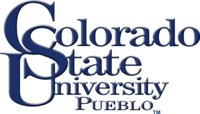University of Southern Colorado
 |
|
|
Former names
|
University of Southern Colorado (1975–2003) Southern Colorado State College (1961–1975) Pueblo Junior College (1937–1961) Southern Colorado Junior College (1933–1937) |
|---|---|
| Type | Public, HSI |
| Established | 1933 |
| Chancellor | Tony Frank |
| President | Timothy Mottet |
|
Academic staff
|
384 |
| Undergraduates | 4,762 |
| Postgraduates | 174 |
| Location | Pueblo, Colorado, U.S. |
| Campus | Urban, 279 acres (112.9 ha) |
| Colors | Blue & Red |
| Athletics | NCAA Division II – Rocky Mountain |
| Nickname | ThunderWolves |
| Mascot | Wolfie (Costume) Tundra (Living mascot) |
| Website | www |
 |
|
Colorado State University–Pueblo (CSU–Pueblo) is a regional comprehensive public university located in Pueblo, Colorado, United States. CSU-Pueblo is a member of the Colorado State University System (CSU System), along with the system's flagship and the state's land-grant university, Colorado State University (CSU) in Fort Collins and Colorado State University-Global Campus, the nation’s first, independent, 100% online public university. CSU-Pueblo is a federally designated Hispanic-Serving Institution (HSI).
Colorado State University–Pueblo has evolved from a three-room junior college on the third floor of the Pueblo County Courthouse with 63 students and two (2) instructors to a regional comprehensive university offering 29 baccalaureate and six master's degree programs, serving more than 5,000 students from all 50 states and 23 countries. Over the past 75 years under four different names, the institution has graduated more than 35,000 students from 41 states and 32 countries. Today, more than 14,000 graduates live in Colorado.
The idea for starting a college in Pueblo was initially proposed in 1926, when a bill was put before the state Senate to begin a four-year school in the city. The bill was defeated by one vote.
In the years following the Great Depression, the idea for a college in Pueblo was revived through the efforts of a local school teacher at Centennial High School, Eric T. Kelly.
At the time, Pueblo's primary employer, steelmaker Colorado Fuel & Iron Corp., was no longer hiring, drought and dust storms were plaguing all of Southern Colorado and the city still was trying to recover from the devastating floods of 1921.
Kelly organized a committee that was composed of several local business leaders to discuss the possibility of getting a college started, among them Frank Hoag, Jr., publisher of The Pueblo Chieftain and Star-Journal newspapers, Dr. C.N. Caldwell and J. Arthur Phelps.
The school originally was planned to be named San Isabel Junior College, but by the time the school had received incorporation it was changed to Southern Colorado Junior College (SCJC). The name change was made in an effort to broaden the recruitment area for the college.
The first classes at SCJC were held in the fall of 1933 in three vacant rooms on the third-floor of the Pueblo County Courthouse. Sixty-three students (31 full-time and 32 part-time) enrolled and the staff consisted of two full-time and eight part-time instructors, a registrar and Kelly, who agreed to serve as the dean of students, of that first class of students, 17 would earn a degree with the first graduating class of 1935.
...
Wikipedia
